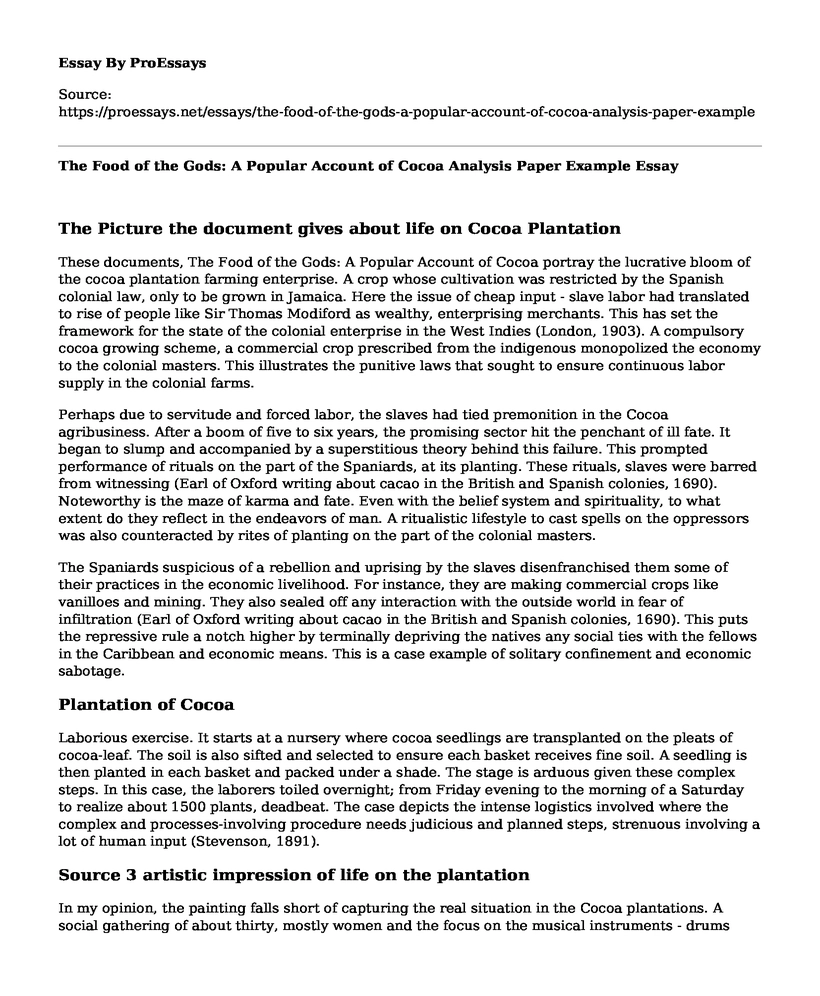The Picture the document gives about life on Cocoa Plantation
These documents, The Food of the Gods: A Popular Account of Cocoa portray the lucrative bloom of the cocoa plantation farming enterprise. A crop whose cultivation was restricted by the Spanish colonial law, only to be grown in Jamaica. Here the issue of cheap input - slave labor had translated to rise of people like Sir Thomas Modiford as wealthy, enterprising merchants. This has set the framework for the state of the colonial enterprise in the West Indies (London, 1903). A compulsory cocoa growing scheme, a commercial crop prescribed from the indigenous monopolized the economy to the colonial masters. This illustrates the punitive laws that sought to ensure continuous labor supply in the colonial farms.
Perhaps due to servitude and forced labor, the slaves had tied premonition in the Cocoa agribusiness. After a boom of five to six years, the promising sector hit the penchant of ill fate. It began to slump and accompanied by a superstitious theory behind this failure. This prompted performance of rituals on the part of the Spaniards, at its planting. These rituals, slaves were barred from witnessing (Earl of Oxford writing about cacao in the British and Spanish colonies, 1690). Noteworthy is the maze of karma and fate. Even with the belief system and spirituality, to what extent do they reflect in the endeavors of man. A ritualistic lifestyle to cast spells on the oppressors was also counteracted by rites of planting on the part of the colonial masters.
The Spaniards suspicious of a rebellion and uprising by the slaves disenfranchised them some of their practices in the economic livelihood. For instance, they are making commercial crops like vanilloes and mining. They also sealed off any interaction with the outside world in fear of infiltration (Earl of Oxford writing about cacao in the British and Spanish colonies, 1690). This puts the repressive rule a notch higher by terminally depriving the natives any social ties with the fellows in the Caribbean and economic means. This is a case example of solitary confinement and economic sabotage.
Plantation of Cocoa
Laborious exercise. It starts at a nursery where cocoa seedlings are transplanted on the pleats of cocoa-leaf. The soil is also sifted and selected to ensure each basket receives fine soil. A seedling is then planted in each basket and packed under a shade. The stage is arduous given these complex steps. In this case, the laborers toiled overnight; from Friday evening to the morning of a Saturday to realize about 1500 plants, deadbeat. The case depicts the intense logistics involved where the complex and processes-involving procedure needs judicious and planned steps, strenuous involving a lot of human input (Stevenson, 1891).
Source 3 artistic impression of life on the plantation
In my opinion, the painting falls short of capturing the real situation in the Cocoa plantations. A social gathering of about thirty, mostly women and the focus on the musical instruments - drums some relics like small jars imply a festivity. The action seemingly, is a dance by two women as dictated by their postures, with three men strapped drums around the necks amidst a watching gathering. The setting in an open field and not an estate or plantation further directs the message of a plantation setting. Even in the knowledge of the rituals performed at planting, I am less convicted this was one. What one could expect is slaves toiling and moiling under the watch of their masters, in a vast plantation. Therefore, the art digressed units' primal role of imitating life, at least in this context (Painting of Indian workers on a cacao plantation in Trinidad, 1903).
References
Earl of Oxford writing about cacao in the British and Spanish colonies. (1690)
London, R.. B (1903). Brandon Head, the Food of the Gods: A Popular Account of Cocoa.
Painting of Indian workers on a cacao plantation in Trinidad. (1903).
Stevenson, R. L. (1891). Writing about planting cacao in the Samoan Islands. (South Pacific). 1891
Cite this page
The Food of the Gods: A Popular Account of Cocoa Analysis Paper Example. (2022, Dec 04). Retrieved from https://proessays.net/essays/the-food-of-the-gods-a-popular-account-of-cocoa-analysis-paper-example
If you are the original author of this essay and no longer wish to have it published on the ProEssays website, please click below to request its removal:
- Essay Sample on Differences Between the South and North in the Period From 1830-To-1860
- The President Fog and War - Essay Sample
- Essay Example on WW1: Britain & France Divide the Middle East
- Essay Sample on the Samurai: The Warriors of the Bow and Arrow
- America's History: The Impact of Settlement & Events on Development - Essay Sample
- Civil War: The Turning Point of American Economy - Essay Sample
- Essay Example on Mystery of the Ancient Egyptian Pyramids: A Wonder of the Ages







